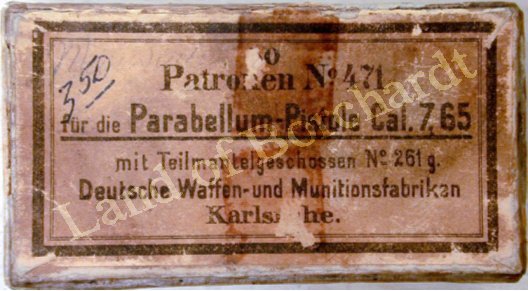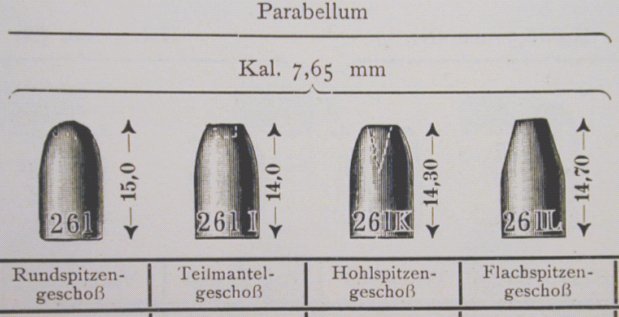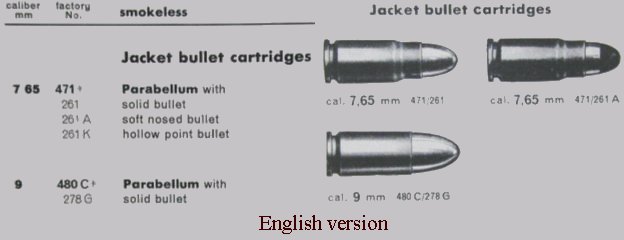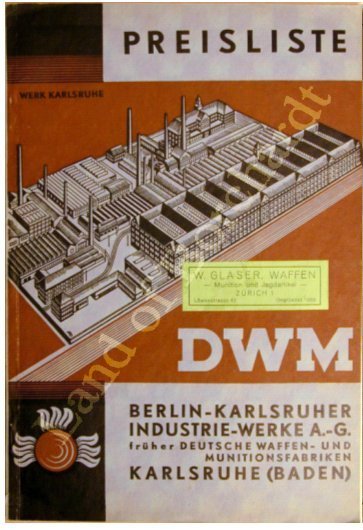1900 Parabellum-Pistole ammunition article

 Home page
Article created: Thursday, January 6, 2005
Home page
Article created: Thursday, January 6, 2005

InroductionThe firm of Deutsche Metallpatronenfabrik (DM), a prominent German manufacturer of cartridge cases (Patronen) and projectiles (Geschossen), was formed in February 1889. In 1896, DM changed its name to Deutsche Waffen und Munitionsfabriken (DWM). As early as February 1900, DWM had applied to register ‘Parabellum’, and by the end of the year the gun had been renamed ‘Selbstlade-Pistole Parabellum, System Borchardt-Luger’1.Four boxes of early DWM packaged ammunition from this period are the subject of this article. Careful examination of the labels and contents of these boxes provides interesting insights on their production dates and history. The boxes are designated as boxes 1, 2, 3, and 4 for the purpose of discussion. The first box (box 1) in all probability is the one of the earliest ammunition packaging for the 1893 C93 Borchardt and also one the earliest with the DWM name on the label. Box 4 is packaged by DWM for the C96 Mauser in the same time frame as the C93 Borchardt. Boxes 2 and 3 are packaged for the Model 1900 Luger or Parabellum with box 2 being possibly the first packaged 7.65 m\m ‘Parabellum’ ammunition. Ammunition Box LabelsThe label of box 2 is unique as it describes the Luger as “Parabellum-Pistole” rather than the more recognizable phrase found on box 3 zur Selbstlade-Pistole Kal. 7.65 m\m (Self-loading Pistol). It has a single line entry with Parabellum being the only designation and case No. 471 identifying the cartridge. However, the notation “No. 261g.” with 261 identifying the Parabellum projectile and the letter suffix identifying the projectile style is very unusual and never seen on any other early 1900 DWM ammunition box labels. To be clear, the letter “g” doesn’t mean weight, but rather a designation, as the notation specifies “No.” or number. The DWM projectile style classification 261 is for the 7.65 m\m Parabellum. It is listed in the 1904 DWM Munitions-Katalog with an “I” suffix, not “g”. The suffix does not appear in any later period DWM ammunition catalogs. The “g” designation of No 261g has not, until now, been associated with this DWM 261 style projectile (geschoß).
For information purposes the 1904 catalog lists four 7.65 m\m Parabellum 261 style projectiles  and the 1939 DWM Ammunition Catalog shows only three styles for the 7.65 m\m Parabellum.  By 1939, Teilmantelgeschoß (part coated projectile) and Flachspitzengeschoß (flat-pointed projectile) were dropped from the catalog and Teilmantel Rundkopf (soft-nosed 261A projectile) was added. The complete phrase “mit Teilmantelgeschossen” on box 2 describes the round as “with Partial coat(ed) projectiles”. This correctly identifies the bullets contained in the box as identical to other known boxed DWM ammunition with Theilmantelgeschosse on the label. This makes the subject box contents correct and original. The “Theil” of the Theilmantelgeschossen spelling on box 1 and the “Theil” of the Theilmantelgeschosse spelling on box 3 are the early spelling of “Partial” coat(ed) projectiles. The “Teil” of Teilmantelgeschossen on box 2 is the later spelling of “Partial”. These spellings were recognized by the Staatliche Orthographie-Conferenz (German National Orthographic (language) Conference) in late 1901 and made law by the Reichstag a year later in 1902. Interpretations by some Luger experts that the earlier spelling of “Theil” can be found before and after the 1901 date but the later “Teil” spelling can only be found after the 1901 date is an oversimplification and not completely accurate as explained below. The plural spelling of projectiles (geschossen) on both box 1 and 2, Theilmantelgeschossen and Teilmantelgeschossen respectively, has been determined to be the pre-1901 plural spelling. The post-1901 plural spelling of projectiles was “geschosse” (dropping the “n”). If this is the case then there is a seeming contradiction in the complete spelling of the word. Both spellings cannot be correct chronologically. Actually, both spellings can co-exist because the German language is noted for its “run-on” word structure. In this case the phrase “Teil-mantel-geschossen” is comprised of three words, meaning partial coat(ed) projectiles, “Teil” being the “new or later” spelling. “Mantel” remains unchanged. “Geschossen” is the unchanged old plural (pre-1901) spelling of projectiles vs. the later current recognized plural spelling of “geschosse”. Box 3’s spelling of “Theilmantelgeschosse” is another example of mixed old and new words, in this instance “Theil” being the old (pre-1901) spelling combined with the later (post-1901) plural spelling of “geschosse”. Another German language schism is found on boxes 1, 2 and 4 with the abbreviated early spelling of “Cal.” for caliber (calibre). The letter “C” vs. the later box 3 “K” (Kaliber) implies that “Caliber” is the earlier spelling and “Kal.” is the later spelling. The earlier spelling is found on DWM Borchardt ammunition labels and on most all early 1900 - 1906 DWM Parabellum ammunition boxes, purportedly packaged before box 3. As the above example of definitions in the 1901 German National Orthographic Conference illustrates, one cannot always rely on a specific point in time for word spelling changes. The changes recommended by these conferences sometimes officially recognize or merely reflect new spellings or language changes already in use, such as “Teil” vs. “Theil” (part) and “geschosse” vs. “geschossen” (which may have come into common usage before the 1901 conference.) There are, for example, circa 1903 carbine ammunition box labels with the (pre-1901) “mixed” spelling of Theilmantelgeschosse packaged for the Model “1902” Luger carbine which wasn’t introduced until circa 1903. The label information of box 3, which was apparently packaged in the same or overlapping time frame as box 2, has some similarities to both box 1 and 2, but contains the earlier “mixed” spellings of Theilmantelgeschosse, and the later abbreviated spelling of “Kal.” (Kaliber). The labels of boxes 1 and 2 are the rarest and seem to have the most in common in both the label information and commonality of *DM*K. headstamp box contents. If box 2 was packaged later than box 3, then there can be no chronological conclusions based on the specific spelling of the box label words alone. However the box graphics (i.e., layout and printmaking) along with the phraseology or similarity of descriptions can be used to date the box. In this case the similarity of the DWM C93 Borchardt ammunition label and the DWM “Parabellum-Pistole” ammunition label provide telling clues. The descriptive title “Parabellum-Pistole” alone dates the box from February 1900. The introduction by DWM of the word “Parabellum” dates the box to no later than December 1900 when the “Selbstlade-Pistole” name was introduced by DWM. Ammunition HeadstampsAnother determining factor of age is the contents of the box. In the case of box 1 there is no doubt as to the packaging date being the earliest as it is for the circa 1893 C93 Borchardt automatic pistol, although an overlap is possible as DWM could have packaged C93 Borchardt ammunition beyond 1902.It should be noted the C93 Borchardt round is not mentioned or shown in the 1904 DWM Munitions-Katalog. Comparison of boxes 2 and 3 reveals that box 2 has 50 rounds of Deutsche Metallpatronenfabrik-Karlsruhe *DM*K. head stamped cases vs. the 50 rounds of DWM-Karlsruhe KKDWM471. case head stamped bullets, which is found packaged in all box 3 style labeled boxes. The logical conclusion would be that box 2 was packaged earlier than box 3. Here again DWM could have been using the old DM case die set, but apparently for one style of bullet (261I (g) only as defined by the 1904 DWM munitions catalog) which is, as yet, unexplainable. It is interesting that both DWM labeled boxes 1, 2 and 4 have the rather generic, non descriptive *DM*K. head case stamp, all with brass primers for two specifically different cartridge case dimensions (the C93 Borchardt and C96 Mauser cases are dimensionally the same). Three different model pistols, the 1893 C93 Borchardt, the C96 Mauser and the model 1900 Borchardt-Luger share this feature as well. What has been stated with respect to the DWM C93 Borchardt pistol packaged ammunition can be said of the box 2 Parabellum-Pistol packaged ammunition as well; that once separated from the box it is unidentifiable. This situation in itself would be compelling enough for DWM to design a new headstamp die for the Borchardt-Luger cartridge case with the 471 case identification, being even more important than the addition of the DWM headstamp company logo. It is exactly this situation that would argue against the commercial packaging of the non descriptive generic *DM*K. head stamped “Parabellum-Pistole” ammunition beyond 1900. This argument refutes suggestions by some authorities that later packing “of using up old stock loaded in the earlier *DM*K. head stamped cases which hung around until boxed up for sale”, with the result that it “was deleted from their listings for lack of sales.” The newness of the 1898-1899 7.65 m\m 471 case style is contrary to any argument of huge stocks of *DM*K. head stamped 471 style Parabellum cartridges beyond 1900, no less packaged, as by December 1900 the first Swiss contract batch of 2000 pistols had not been delivered. The Swiss purchased the first batches from DWM and didn’t start manufacturing and packaging their own ammunition for the Swiss Ordonnanzpistolen 1900 until circa 1903 when it was replaced by the ‘Ordnannanz Pistolenpatrone Model 1903. The case for any excess inventory of DM*K* head stamped 7.65 m\m Parabellum ammunition for commercial packaging is not reasonable as the bulk of inventory, if any, would be dedicated to the Swiss contract. The Teilmantelgeschoß 7.65 m\m 261 projectile, which was the earlier (pre-1904 g suffix designation was replaced with the letter “I” yet was apparently discontinued along with the Flachspitzengeschoß 261L (Flat pointed) projectile sometime in the 1920s, as the Teilmantelgeschosse designation is last seen on Berlin-Karlsruher-Industrie-Werke Akt.Ges. (BKIW) ammunition labels. The “g” designation curiously was assigned to the recently invented 9 m\m 278 style round nosed (ogival) bullet or projectile “Rundspitzengeschoß”in the 1904 DWM Munitions-Katalog and retained the 1904 DWM Munitions Katalog assigned now “upper case” G suffix designation through the 1939 DWM ammunition catalog. An earlier version of this 7.65 m\m round was packaged as a carbine round as identified by its chemically blackened case and 1920s 471A headstamp. As of this writing no other DWM box label has been identified by the author with a soft nosed (lead) bullet description as seen on the earlier boxes. The English and German language versions of the 1939 DWM catalog show a 7.65 m\m ‘soft nosed round’ identified as 261A and pictorially more recognizable as a round nosed, lead tip projectile vs. the 1904 DWM catalog picture of 261I. The German language description and word structure is different in the 1939 DWM catalog being Teilmantel – Rundkopf or “Partial jacketed (coated) – Round pointed.” (Note Kopf vs. the earlier Spitzen for “Point”). Also note the 1904’s 261K “Hohlspitzengeschoß” or Hollow point projectile vs. the later 1930’s 261K German language spelling of Teilmantel - Loch or Partial jacketed (coated) –Loch with “Loch” for “Hole” or “Hollow”. (see tables above) The soft nosed (lead) bullet style as described and pictured in the 1939 catalog is not the same as listed in the 1904 catalog and the period German language descriptive text changed although “Weichesgerochenesgeschoß” is the modern German language singular spelling of “Soft nosed projectile”, as defined by a modern web site translator. It is also very interesting to note along with the similarity of label information of the early DWM box labels for the C93 Borchardt and the first interim ammunition box label for the “Parabellum-Pistol”, the label covered only the top of the box, which included the complete company name of Deutsch Waffen und-Munitionsfabriken along with the manufacturing location Karlsruhe. The label was completely redesigned for the Parabellum ammunition to the December 1900 new name of “zur Selbstlade-Pistole”. The length of the new label was extended to wrap around and cover each end of the box to act as a seal for the box. The DWM name and Karlsruhe was relocated to each left and right side edge of the extended label thereby leaving more room for a single line, larger bold single word printing of “Parabellum” (the new name registered by DWM in April 1900) and additional information. It is most likely in this time frame that the headstamp information was changed from DM*K* to K DWM 471 K. The short run of the “Parabellum-Pistole” interim label of no more than a few months explains why this label and its DM*K* head stamped contents are rare and why there are no other loadings found for this label. There is another example of early boxed carbine ammunition for the Model 1902 Luger carbine with the mixed spelling of Theilmantelgeschosse. Note the use of the German word of “zum” vs. “zur” meaning “to” or “to the”. Interestingly the box is stamped “Made in Germany” a requirement of the US Firearms Act of 1890, implemented at the end of 1902 to identify non-American goods. The carbine box was apparently imported post 1902 and although not defining the manufacturing date does indicate the continued post 1902 use of the mixed spelling of “Theilmantelgeschosse”. The subject “Parabellum-Pistole” labeled box lacks a “Made in Germany” import stamp and based on the US Firearms Act of 1890 was imported prior to 1902, which again does not define the manufacturing date but does indicate pre-1902 export.  1932 Berlin-Karlsruher Industrie-Werke A.-G. Preisliste (catalog) |